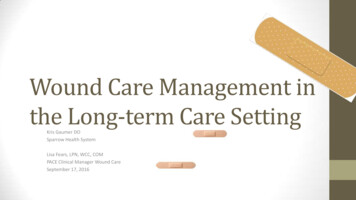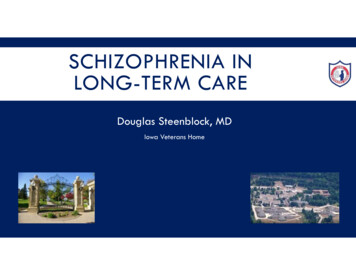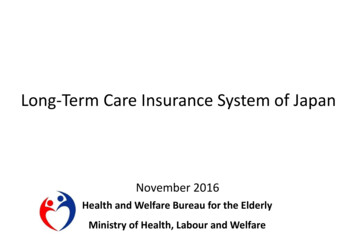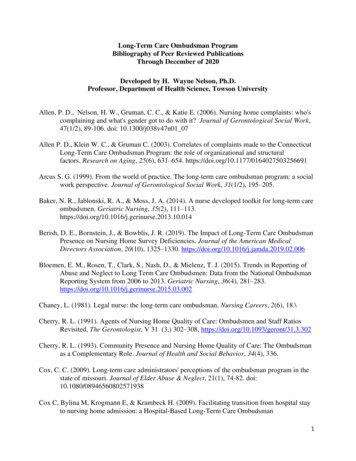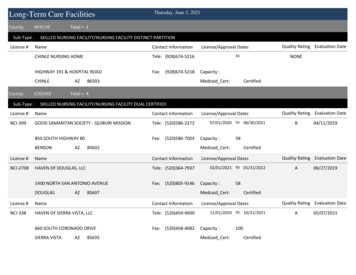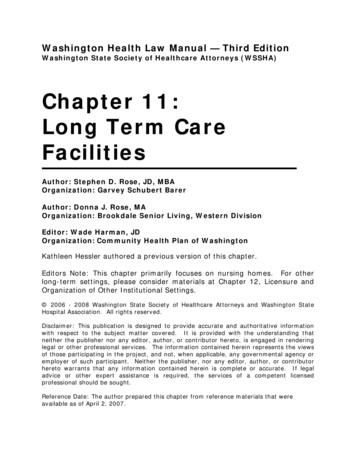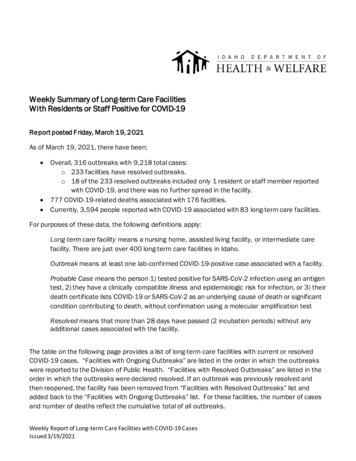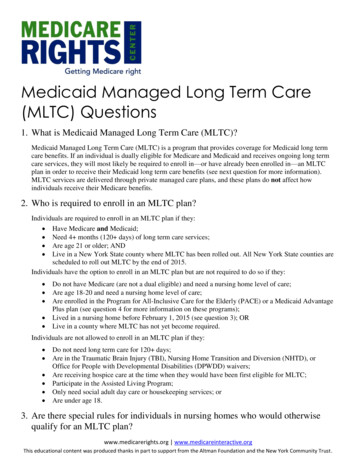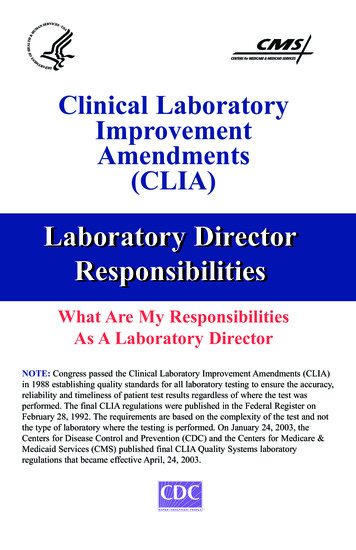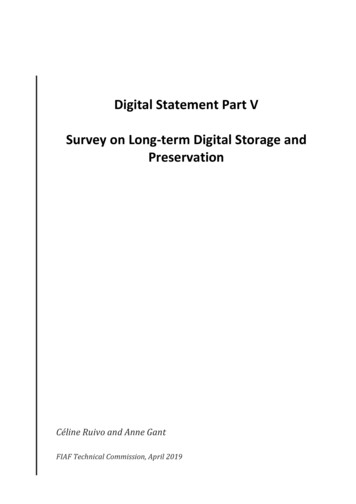
Transcription
THELong-Term CareDirector of NursingFIELD GUIDEThird EditionBarbara Acello, MS, RNForeword written by Sherrie Dornberger, RNC, CDONA, FACDONA
THELong-Term CareDirector of NursingFIELD GUIDEThird EditionBarbara Acello, MS, RNForeword written by Sherrie Dornberger, RNC, CDONA, FACDONA
The Long-Term Care Director of Nursing Field Guide, Third Edition, is published by HCPro, an H3.Group division of Simplify Compliance, LLC.Copyright 2017 Barbara Acello.All rights reserved. Printed in the United States of America.5 4 3 2 1Download the additional materials of this book at www.hcpro.com/downloads/12610.ISBN: 978-1-68308-649-9No part of this publication may be reproduced, in any form or by any means, without prior written consent ofBarbara Acello or the Copyright Clearance Center (978-750-8400). Please notify us immediately if you havereceived an unauthorized copy.HCPro provides information resources for the healthcare industry.HCPro is not affiliated in any way with The Joint Commission, which owns the JCAHO and Joint Commissiontrademarks.Barbara Acello, MS, RN, AuthorBetty Bruner, RN, BS, NHA, CDONA, FACDONA, ReviewerSherrie Dornberger, RN, CDP, CADDCT, GDCN , CDONA , FACDONA, IP-BC of NADONA, ReviewerOlivia MacDonald, Managing EditorAdrienne Trivers, Product DirectorErin Callahan, Vice President, Product Development & Content StrategyElizabeth Petersen, Executive Vice President, HealthcareMatt Sharpe, Senior Manager of ProductionVincent Skyers, Design Services DirectorVicki McMahan, Sr. Graphic DesignerSheryl Boutin, Layout/Graphic DesignHayden Ohmes, Cover DesignerAdvice given is general. Readers should consult professional counsel for specific legal, ethical, or clinical questions.Arrangements can be made for quantity discounts. For more information, contact:HCPro100 Winners Circle Suite 300Brentwood, TN 37027Telephone: 800-650-6787 or 781-639-1872Fax: 800-785-9212Email: customerservice@hcpro.comVisit HCPro online at: www.hcpro.com and www.hcmarketplace.com
DedicationLaura Christine Acello Fowler(1971 – 2017)This book is dedicated to my loving, giving, beautiful,and intelligent daughter who was taken from us far too soon.Godspeed, my child.The Long-Term Care Director of Nursing Field Guide, Third Edition 2017 Barbara Acelloiii
DOWNLOADABLE MaterialsDownload the associated materials by clicking on the link below.www.hcpro.com/downloads/12610iv 2017 Barbara AcelloThe Long-Term Care Director of Nursing Field Guide, Third Edition
ContentsIntroduction. ixAcknowledgments. xiChapter 1: The Director of Nursing’s Role in Leadership. 1Director of Nursing Responsibilities. 1What Is Leadership? . 4Four Basic Leadership Styles. 6Identifying the Best Leadership Style for the Situation. 8Chapter 2: The New Employee. 11Interviewing and Hiring Employees.11Make the Offer and Close Out the Process. 23Hiring a New Manager.24Designing an Effective Managerial Orientation .33Orientation Topics. 36Role of the Manager. 40Chapter 3: Communication. 49Perceptions.49Ways of Improving Your Communication . 50Communicating With the Administrator.52“Managing Up”.52Providing Feedback to Staff.53The Art of Active Listening. 54Changes to Long-Term Care Requirements of Participation.55Chapter 4: Long-Term Care Facility Finance. 57The Strategic Plan.57Understanding the Impact of Staffing on Payroll Costs.59Understanding How to Budget. 60The Long-Term Care Director of Nursing Field Guide, Third Edition 2017 Barbara Acellov
ContentsUnderstanding Income and Payer Sources.61Financial Statements. 66Strategic Planning. 66Chapter 5: Planning and Budgeting. 69The Strategic Plan. 69Cost Containment in Long-Term Care.73Types of Cost.73Chapter 6: Time Management and Delegation. 77“Time Crooks” . 77Delegation . 80Confronting Procrastination .83Chapter 7: Conflict Resolution and Managing Complaints. 87Conflict. 87Resolving Conflict. 88Managerial Conflict Resolution.93Facility Policies. 94Chapter 8: Understanding Others. 97The LGBT Resident.107Chapter 9: Assessing Competencies.117Types of Competencies.118Choosing Competencies to Be Assessed .118Validation Methodologies.121Performance Evaluations.125Chapter 10: Standards of Care. 129Professional Responsibility.129Quality of Care.133Nursing Process Breakdown.134Person-Centered Care.134Care Planning.135Transitional Care.137Quality of Life.138Culture Change in Long-Term Care.139Assessing Pain in Persons Who Are Elderly. 141vi 2017 Barbara AcelloThe Long-Term Care Director of Nursing Field Guide, Third Edition
ContentsEnd-of-Life Care.143Restraints.146Chapter 11: Quality Assurance/Benchmarking.149The Quality Assessment and Assurance Committee.149A Commitment to Quality.150Benchmarking. 152Root Cause Analysis.154The Governing Body.156Confidentiality of QA & A Committee Data.158The State Supreme Court Opinions. 159Chapter 12: Infection Prevention and Control. 165The Centers for Disease Control and Prevention (CDC).165Facility Responsibilities.165Hand Hygiene. 167Common Infections. 167Antibiotic Stewardship.171The Bugs Are Too Smart.172Drug Resistance. 174Carbapenem-Resistant Enterobacteriaceae (CRE). 175Candida auris. 176Spores. 176Diarrhea.177Clostridium difficile.178Norovirus.180Routine Environmental Cleaning.181Pathogen Threat List.182Common Fomites Used by Nurses.184Legionnaires’ Disease.187Wound Culture.189Urinary Tract Infection.192The Centers for Disease Control and Prevention (CDC).199Chapter 13: Residents With Pressure Injuries. 203Important New Information.203Staging Pressure Injuries. 208NPUAP Stages and Definitions. 208The Kennedy Terminal Ulcer.211The Long-Term Care Director of Nursing Field Guide, Third Edition 2017 Barbara Acellovii
ContentsPalliative Care/Hospice Care.212Gangrene. 215Necrotizing Fasciitis. 217Reverse Staging (Backstaging).220Pressure Injuries and the MDS.221Chapter 14: Risk Management. 223Use of Outside Resources.223Patient Self-Determination Act (PSDA).230Cardiopulmonary Resuscitation (CPR) .231Use of Oxygen in an Emergency.235Incident Reports.238Risk-Reduction Programs.246Need for Person-Centered Care.246Learning From Errors.250Public Image When an Accident Occurs.251Chapter 15: Regulatory Compliance. 253Changes in the Long-Term Care Facility Rules.253CMS State Operations Manual (SOM).254Dr. Black, You Have a Call on Line 4!.255Moving Right Along.255The Long-Term Care Facility Survey.257The 2567 . 260Informal Dispute Resolution (IDR).261Value-Based Care. 264Special Focus Facility (SFF) Program. 264Hurricane Katrina.267Hurricane Rita. 268Appendix Z.269Education.270viii 2017 Barbara AcelloThe Long-Term Care Director of Nursing Field Guide, Third Edition
ForewordHaving been a DON for over 30 years, one of my biggest complaints was there is a lack of reference materials geared to help me do my job. No one had put together a comprehensive guideof policies, employee issues, leadership, successful orientation for the newly hired employee,conflict management, risk management, benchmarking, and delegation to name a few.I have always said that DONs need a bit of attention deficit disorder to do a great job. If weconcentrate on any one area for too long, 20 more issues would have passed us by. DONshave 20 issues or crises coming at them at once. They need to learn delegation, and docu mentation to survive. After all we are endangered species, aren’t we?I think this book will be the DONs’ bible. It brings many pieces of information that areneeded to do a great job together into one book. For new DONs, or DONs who may be looking to sit for the certification exam, it is a great learning tool. Seasoned DONs will also benefit by brushing up on areas that may not be our ‘favorites’ or best things to do. No one is anexpert at everything, but this book will definitely enhance what you know and are able todo well! You will find additional useful information and geriatric clinical content atwww.hcpro.com/downloads/12610.This book was developed with the NADONA certification exam in mind, taking subjectareas of the exam and creating chapters of the books to mirror the subject matter. As a nurseadministrator we are much too busy to, as “they say,” recreate the wheel. The information ishere, all in a comprehensive format, and easy to understand, well-written, and reviewed bynurses working in the long-term care continuum on a daily basis. This will be one of the mostused resources in your office library!For those who are not DONs, it would also be a great motivator, and perhaps even a steppingstone to prepare our colleagues who may want to move up in the long-term care continuumas a supervisor, nurse manager, ADON, clinical care coordinator, wellness nurse, and on andon! Whether you work in assisted living, skilled care, adult day care, rehab short stay, thisbook will help you. We all have the same situations in different areas of work, but the samegoal of providing the best quality of care for those under our supervision, and I am sure youwill not regret owning this wonderful resource!Sherrie Dornberger, RNC, CDONA, FACDONANational Association Directors of Nursing AdministrationPresidentThe Long-Term Care Director of Nursing Field Guide, Third Edition 2017 Barbara Acelloix
IntroductionWe are in a time of great transition. The long-term care rules were overhauled in 1987 in theOmnibus Budget Reconciliation Act (OBRA). How time flies when you’re having fun! It doesn’tseem like that was 30 years ago! Those rules became effective in 1991. Considering the time,the rules were very progressive and forward thinking. The Minimum Data Set (MDS) was newto us. That alone has made a profound impact on long-term care. The introduction of the MDSevolved into a large nursing specialty with numerous resources. A group of forward-thinkingnurses created a professional organization for MDS nurses in 1999. Today, this group is 14,700members strong. The MDS nurse has proven to be one of the most important nurse leaders inthe facility. The nurses who organized the MDS nurses and established the professional organization have made an exemplary contribution to long-term care, affecting both caregivingand reimbursement.Laws are also called statutes. Your state and federal legislators write the laws that determinewhat each license holder can do. They also establish guidelines and grant authority for regulatory agencies to make rules. A number of federal agencies also have rules affecting healthrelated businesses. Your State Board of Nursing and Department of Health are the two primary agencies that write rules for nursing practice and long-term care facilities in your state.They also determine how the rules will be applied.Rules and regulations are much more comprehensive and specific than laws. They explainhow to correctly implement the law. Rules also address standards of conduct and can bechanged or updated frequently. In some situations, state and federal rules conflict. In this case,follow the rules that are the strictest.Stay informed regarding issues affecting nursing practice. Rules and laws are always changing. Theyusually become stricter. They are seldom relaxed. Resident acuity has increased because hospitalsdischarge patients earlier and sicker than before. Healthcare is very reimbursement driven. Thisaffects admission, discharge, length of stay, and whether the resident requires readmission to thehospital within 30 days of discharge. Some areas of the United States have a nursing shortage, andcomplying with regulations and caring for residents has become much more difficult than it was inthe past. Something new is always trending, and there is much important information to share.The Centers for Medicare and Medicaid services (CMS) has recently overhauled the longterm care facility rules and regulations. We wish we had a crystal ball so we could give youdetailed information on how to implement these rules. Unfortunately, CMS will not disclosetheir secrets to us. It is probable that the new rules will be tweaked and modified. We are allThe Long-Term Care Director of Nursing Field Guide, Third Edition 2017 Barbara Acelloxi
Introductionlearning, and chances are that we will need to update this book in a year or two, when additional information is available.Regulatory demands are changing rapidly. Many nurse managers and administrators are approaching the new rules with fear and trepidation. We did the same thing with OBRA. You are in thisbusiness because you are committed to long-term care and enjoy working with the geriatric population. You can do this. Take it one step at a time. Keep your goals in mind.This book contains updated regulatory information. Infection control is another area that isevolving quickly, so we have included significant infection-related information. Note that CMShas added new emphasis to infection prevention. To this point, infection control has been thefocus. Most facilities give flu shots and pneumonia shots, and apply the principles of standardprecautions. Yes, these measures prevent infection, but much more can be done. Facilities witha comprehensive program for addressing both prevention and control of infection will havehealthier residents and staff.Read the new rules and commit them to memory. Yes, this is a lot of reading, but it is the onlyway to become familiar with them. Keep them handy, and make sure your key staff can accessthem 24 hours a day and know how to use them. We have provided various sources of information and references. There is an abundance of information in the search engines as well. Makesure you are using credible sources, such as CMS and other government agencies and professionallong-term care and nursing organizations for RNs and licensed practical nurses.Do not forget to check the downloads section of the book. You will find additional helpfulinformation and resources there. Please check it periodically. We will add important newchanges to this section as they evolve. Surveyors often request copies of specific policies andprocedures. Some regions have reported that surveyors have reviewed the same procedures inevery building. We have included procedures that have been frequently requested. If there areothers, please let us know.I am honored if you are a reader who selected this book to study for a certification exam.I sincerely hope this information is useful to you. The Institute for Credentialing Excellence(ICE) defines certification as “a voluntary process instituted by a non-governmental agency bywhich individuals are recognized for advanced knowledge and skill.” Professional certificationaffirms the advanced skill, professional knowledge, and experience of distinguished leaders.Good luck with your mission to provide quality long-term care and management of the largestand most complex department in the facility. Geriatric care is my first love, and I sincerelyadmire those who work in the difficult financial and regulatory environment we call longterm care. I believe in you, support you, admire your commitment, and sincerely hope thatthis information is useful to you in providing quality care and making a difference in the livesof the residents. If you have suggestions, questions, or comments, feel free to email me atbacello@aol.com. We also welcome suggestions for the next edition of this book.Barbara Acello, October 2017xii 2017 Barbara AcelloThe Long-Term Care Director of Nursing Field Guide, Third Edition
AcknowledgmentsThe Long-Term Care Director of Nursing Field Guide was written with the personal and professional collaboration of an interdisciplinary group of colleagues. I am sincerely grateful for theassistance and cooperation of:Christin Delahay, LNHA, CDP, and Michael Hotz, LNHA, CNHA, FACHCA, made a majorcontribution to the information on budgeting in Chapter 4. This is difficult subject matter, andthey explained it succinctly, in an understandable manner.Genevieve Gipson, MEd, CNA, RNC, is always interested and willing to help. I sincerely appreciate her editing the procedures and reviewing nursing assistant information.Betty Bruner, RN, BS, NHA, CDONA, FACDONA, and Sherrie Dornberger, RN, CDP, CADDCT,GDCN , CDONA , FACDONA, IP-BC of the National Association of Di
The Long-Term Care Director of Nursing Field Guide, Third Edition 2017 Barbara Acello ix Having been a DON for over 30 years, one of my biggest complaints was there is a l
